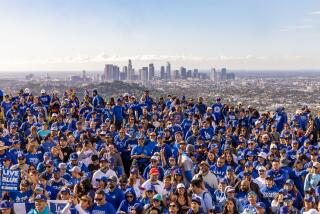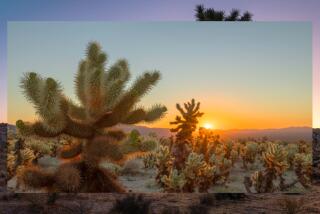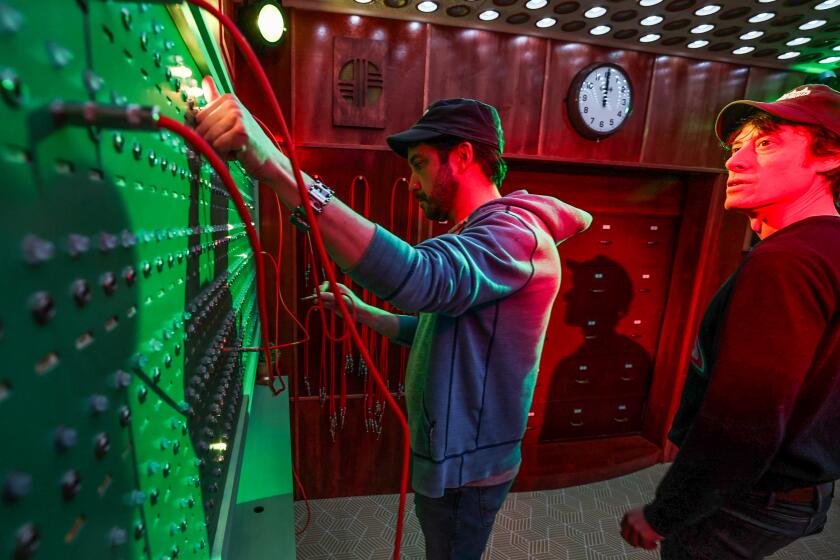The irresistible call of the Grand Canyon

GRAND CANYON NATIONAL PARK, Ariz. — Who hasn’t peered into this brain-bending abyss and failed to conceptualize 6 million years of stream erosion through a vertical mile of primordial rock?
“I’m sorry, but there’s no way a river did that,” huffs a voice among this evening’s mesmerized herd of South Rim-at-sunset gawkers.
The voice belongs to my buddy Mark Segal, 40, a food service account manager from Long Beach. Or maybe it’s my other friend Vic Leyson, 34, a business manager from Studio City. Or maybe it’s me — or anyone else in this silhouetted Grand Canyon Village crowd staring dumbly into the glowing pink-orange megascape.
The next comment, though, is unmistakably Mark’s.
“So that’s what we’re walking to the bottom of tomorrow morning,” he says blankly. He turns away. He’s seen enough. “All right, where’s the bar around here?”
A couple of years ago, Mark, Vic and I tested our aging knees, our semi-firm resolve, our rock-solid-ish friendship by hiking together to the top of Mt. Whitney — and vowing never to do something like that again.
Then the inevitable happened. Amnesia and that restless, middle-age itch to tear ourselves from our families for 72 hours and log another long-weekend bucket-lister with the guys led us to talk about our next big, cheap, doable conquest within two gas tanks of Los Angeles. Where should we plant our flag this time? The discussion lasted about four seconds.
The Grand Canyon. You’ve probably heard of the place.
And perhaps, like us, you might be drawn here by some inexplicable higher calling. Or lower calling, entering the planet’s most famous cleft and hoofing along vertiginous trails to its riverine basement. And (important) walking all the way back up again. Don’t forget that second part.
Some people embark from the canyon’s remote, higher North Rim. Others go rim to rim, walking the canyon’s entire width. A few crazies go rim to rim to rim — hiking down one side, up the other, back down again and out the original side.
Our plan on that brisk weekend in mid-October (brisk at the top, it will be pushing 100 degrees at midday down below) is to backpack the classic South Rim loop. Down the steeper and more exposed, 7-mile South Kaibab Trail to the bottom, camping for a night by the river at Bright Angel Campground, and then back up by the canyon’s main corridor, the 91/2 -mile Bright Angel Trail. Backcountry permits get snatched up months in advance for expeditions such as this, especially during the Grand Canyon’s more temperate fall and spring shoulder seasons. Winters get icy, rainy and frigid. Summers, the most popular time to visit the rim, swelter in the lethal triple digits in the inner gorge during what the park calls its “danger months.”
“A lot of people don’t totally know what they’re getting themselves into in the Grand Canyon, even if they think they do,” says Mark Wunner, the park’s Backcountry Information Center supervisor, who likens the signature rim-to-river hike to an upside-down mountain climb governed by conditions just as extreme, only different. “The fact that those conditions aren’t as immediately obvious as on a snowy summit can make them even more treacherous,” he says.
Friday
6:31 a.m.: The morning’s first load of Hiker Express shuttle riders disembarks at the South Kaibab Trail head (7,260 feet), atop an incomprehensible panorama of pastels and monstrous receding shadows. A dawn moon hangs in the west, ending its shift. The sun’s first reflected rays blast the tip of the North Rim, 10 miles of empty sky away.
“It just doesn’t seem real,” says Vic, setting up a wide-angle-lens-defying shot of the three of us before we head down into the canyon’s gaping jaws.
It’s true. From up here, your eyes can’t help but refab the Grand Canyon into a magnificently fake 1950s Hollywood backdrop. It’s two-dimensional. Not real at all.
“It’ll seem real pretty soon,” Mark mutters as he tightens a strap and blows into his hands. It’s still in the low 40s. We can see our breath. Last night was barely above freezing. Thank God for air mattresses and warm socks.
7:08 a.m.: Get these socks off me. The sun still hasn’t shown its face above the cliffs, but after our first set of switchbacks, my mouth is like sandpaper and it’s already time to strip off layers and swig more water.
7:22 a.m.: At a dizzying overlook called Ooh Aah Point, we stare into the gorgeous void, grinning stupidly. If you’re not experiencing ineffable joy at Ooh Aah Point, please consult your doctor.
“I’m really happy we’re doing this,” says Mark, succumbing. Vic and I nod. Enough said. We continue heading down. Down. Down.
8:35 a.m.: Several plunging switchbacks and some broad, sun-drenched traverses later, we hit Skeleton Point (5,220 feet), the trail’s approximate midway mark and a suggested turnaround spot for day hikers — who appear to show no interest in turning around in spite of posted park warnings, in four languages, that each year hikers suffer serious illness or death from exhaustion by pushing themselves all the way down to the river and back in a single day.
9:12 a.m.: Hiding below Skeleton Point is the descent’s greatest acrophobia test, a narrow, blasted-out ledge that isn’t an ideal place for two-way traffic — but here come the morning’s first heat of pink-faced, sweat-soaked climbers hauling themselves out of the canyon, edging past us with distorted faces that don’t look nearly as joyful as they may have on the way down.
9:30 a.m.: It’s getting hot. Every few hundred feet lower, every few minutes closer to the midday high is a twist on the canyon’s thermostat. The temperature swing today between the rim and the inner gorge will push 60 degrees.
10:19 a.m.: First, we hear it. Then we see it. The Colorado River, swooshing doggedly across the canyon floor. What a bang-up job it’s done, carving mile-deep canyons and quenching the thirst of seven states. We should stop for a moment and pay our respects. Instead, we numbly plod on, past some 900-year-old Anasazi ruins to a row of campsites lined along a burbling stream. Bright Angel Campground (2,480 feet).
“What time is it?” Mark asks with a grimace while rubbing his foot. “Like 4?”
11:11 a.m.: “So this is what heaven looks like,” Mark says with a sigh, basking in Bright Angel Creek, a picturesque, spring-fed brook framed by cottonwood trees, towering red cliffs, rays of hot, desert sun and a huge, imaginary “Payoff” sign. “Lie down right on your stomach,” he tells me as I wade into the cold, shallow water. “Trust me.”
I lie face down on a bed of river stones. An intoxicating sheet of icy water rolls over my heels and calves and spine.
If there’s one reason to hoof all the way down into the Grand Canyon, this must be it.
1-4 p.m.: Or this — an icy glass of lemonade at Phantom Ranch, the canyon’s legendary rustic retreat a short walk along a cactus-lined trail from the campground. Guests can (and should) reserve cabins, dorm bunks and steak dinners more than a year in advance at this 90-year-old, air-conditioned mirage. The rest of us can stumble into the lodge’s canteen between 1 and 4 p.m. to hide from the afternoon heat, guzzle lemonade and read through a box of 30-year-old Trivial Pursuit cards to see who’s the smartest guy at the bottom of the Grand Canyon today.
‘Round midnight: It must be at least that late. I check my watch. 8:06 p.m. Lying wide-eyed at the bottom of the Grand Canyon in an open tent in the pitch dark, one’s grasp of time soon becomes as trivial as any other human pursuit.
It’s the greatest sleepless night of my life, tempered by one little preoccupation. Tomorrow we have to walk out of the Grand Canyon.
Saturday
6:28 a.m.: At sunrise, the canyon reappears in silky, pink light you can almost touch. Ten feet away, a deer stands in the creek having a drink. Hulking above us, the canyon is stunningly, quietly real — nothing two-dimensional about it. You’re really in it down here. That’s the greatest payoff of all.
“This is not going to be fun,” Mark says as he wakes up with a hiker’s worst hangover — a pulled foot muscle. “You guys go on ahead,” he says, staring at the mountainous cliffs. “I’m going to be taking a very, very long time.”
No. We’re sticking together. We’re either walking out of this thing as a band of brothers, or we’re settling down here and opening a new lodge with cheaper lemonade. Three Guys. All for one and one for all.
7:42 a.m.: The safest route back up to the South Rim is the Bright Angel Trail, which follows a massive fault break with shade, ranger stations, emergency phones, water fill-up stops, petroglyph sites and four segments of 1,000-plus-foot climbs that look much friendlier on a national park trail map.
The first major hurdle is an interminable set of switchbacks through a massive, craggy bowl — aptly named the Devil’s Corkscrew. Here, a giggly group of young women jog (yes, jog) past us, down the Devil’s Corkscrew, in bright tutus — one of them with a tiara on her head. A minute later a middle-aged woman (a bachelorette party chaperon perhaps?) trots by in a kilt trying to catch up with them. Are we hallucinating already?
9:25 a.m.: By the time we haul ourselves up to Indian Garden (3,800 feet), a riparian oasis covered in cottonwoods and wildflowers at the trail’s halfway point, the Bright Angel’s morning pageantry of super-fit trailblazers has revealed a serious gender imbalance. About 90% women.
9:42 a.m.: The midway mark may be behind us, but the bulk of the climb is dead ahead. The last four miles feature endless switchbacks on a massive series of steep, sunbaked cliffs furnished with a couple of little rest houses named, deceptively enough, “Three-Mile” and “Mile-and-a-Half.”
“How long to the top from here, would you say?” Mark asks a young park guide, striding up into the cliffs with a small group.
“It really varies,” he counsels. “But it’s not how fast you get up — it’s that you do it with a smile.”
Hmm. Not helpful.
10:11 a.m.: Up we go. Back and forth. Back and forth. Until now, the trip has been grueling at times but mainly spectacular. “Something’s not right,” gasps Mark, craning his neck and peering up at the South Rim. “Is it just me, or does the top keep getting farther and farther away?”
10:42 a.m.: At Three-Mile Resthouse (4,748 feet), Vic pulls ahead and high-tails it to the top alone. What about today’s band-of-brothers pact? Or was that even today? No, that was ages ago.
12:26 p.m.: Then it’s Mark’s turn to move ahead. “How long are you planning on sitting here?” he asks me at One-and-a-Half-Mile Resthouse (5,729 feet).
Perched on a rocky ledge, staring down at the abyss, listening to my pulse, letting a faint altitude headache subside, I notice the Grand Canyon receding into two dimensions.
Some unspecified time later: I must be getting close. Folks are now strolling down Bright Angel Trail in loafers and chatting about dinner reservations.
“You come from the bottom?” a guy in cotton slacks asks me. “How long did it take you?”
I glance at my watch. I’m not sure. Two billion years, give or take? Anyway, it’s not how fast you go, right? It’s whether you go with a smile.
I stop. Throw off my pack. Lean against the Grand Canyon. The Grand Canyon.
And smile.
What a place to work on that lesson.
More to Read
Sign up for The Wild
We’ll help you find the best places to hike, bike and run, as well as the perfect silent spots for meditation and yoga.
You may occasionally receive promotional content from the Los Angeles Times.






